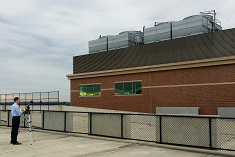This page will answer many of the general questions we receive regarding acoustical issues in buildings and the environment. For answers to more project specific issues, please do not hesitate to call us.
IIC (Impact Insulation Class) Ratings/Tests of Floor/Ceiling Assemblies
1. What is an IIC test or rating?
IIC stands for Impact Insulation Class. An IIC is a single number rating that describes the impact noise reduction provided by a floor/ceiling assembly when subjected to a standardized tapping machine and tested in a laboratory in accordance with ASTM Standard E492.
2. What are the requirements for IIC ratings in multi-family buildings.
The International Building Code minimum requirement for IIC ratings is a laboratory tested 50 for the entire floor/ceiling assembly under consideration. The field measured minimum requirement is 45. However, many condominium documents require better performance than the code minimum for residents looking to install hard surface flooring in their Units. Also, some states may not use the International Building Code or have their own requirements that supersede the International Building Code requirements.
3. I have a resilient underlayment product with an IIC rating of 69. Can I use this in my building?
Possibly not. Underlayment products, on their own, do not have IIC ratings, so if a manufacturer is telling you their product achieves a specific IIC rating, your are being misled. Only entire floor/ceiling assemblies have IIC ratings, of which the underlayment is just one component. It is possible that the floor/ceiling assembly that achieved an IIC rating of 69 would have done so even without the underlayment. We can review the acoustical laboratory test reports to determine if the proposed product meets the project requirements.
4. Can I have the IIC rating of the floors in our condominium building tested?
Yes. But in the case of a field test, it is the AIIC that is tested, not the IIC. AIIC stands for Apparent Impact Insulation Class, and is tested in accordance with ASTM Standard E1007. This is the value that would be compared to the International Building Code minimum of a field-tested IIC of 45. Additionally, the NISR (Normalized Impact Sound Rating) can be calculated from the same measurements. The NISR appears to be the direction the International Code Council is heading in the future with regard to testing impact sound levels to determine compliance with building code requirements.
5. What does an AIIC test consist of?
To test the AIIC rating of a floor/ceiling assembly, the finished flooring product should be installed over the entire room in accordance with the manufacturer’s instructions. A standardized tapping machine is placed on top of the floor being tested and turned on. Measurements of the impact sound pressure level are made in the room below at multiple locations in accordance with ASTM Standard E1007. This is repeated for three additional tapping machine positions/orientations, per the Standard and the resulting sound pressure levels are averaged together. Reverberation time measurements using bursts of pink noise (sounds like static) in the room below are made to determine the sound absorbing effects of the receiving room. A calculation procedure is then used to remove the effects of the receiving room on the measured tapping machine sound pressure level, leaving only the sound reduction provided by the floor/ceiling assembly itself. These data are plotted on a special graph to derive the AIIC rating. The video below will give you an idea of what a typical test consists of.
Video of the main components of an AIIC Test
6. How long does an AIIC test take?
Typically, the testing of a single floor lasts approximately 1.5 hours, but that includes taking physical measurements of all the room dimensions (needed for the calculation procedure), laying out the location of the tapping machine and microphone, documenting the dimensions and locations of the tapping machine and microphones, taking photos, visual observations of the floor installation, and unpacking and packing the gear. The actual tapping lasts approximately 15 minutes, and the pink noise bursts last approximately 15 minutes. If the building is occupied, nearby residents may hear these tests being conducted.
7. How much does an AIIC test cost?
We do not have a set price for a test, as the number of tests, difficulty of access, and other factors will influence the cost. Please call us anytime and we can discuss the costs specific to your project.
8. I am on the Board of Directors of my Condominium Association. What IIC rating should we require for owners wishing to install hard surface flooring?
This question does not have a simple answer. Each project is different, and many factors have to be taken into account before determining the IIC rating to require. What are the minimum code requirements in your area? What is your existing floor assembly? What level of acoustical performance are you trying to achieve? What do your current Condominium Documents require? How do you want to enforce the new requirements? It may also be best to conduct AIIC tests of the existing assemblies so that there is a quantitative, scientific basis for any changes made to the requirements. We can assist you with this process.
Check back later for the answers to more FAQs!

